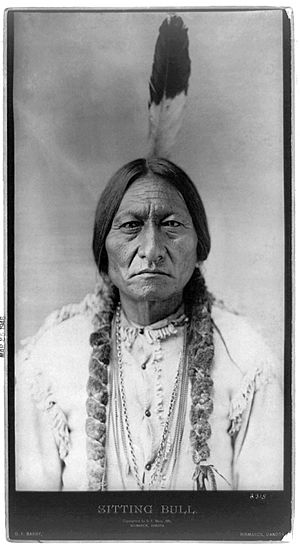Isaiah Dorman facts for kids
Isaiah Dorman (died June 25, 1876) was an interpreter for the United States Army during the American Indian Wars. He died during the famous Battle of the Little Bighorn, and he was the only black man killed in that fight.
Contents
Who Was Isaiah Dorman?
Not much is known about Isaiah Dorman's early life. Some stories say his father was from Jamaica, and his mother was part African and part Lenape (a Native American tribe). He might have been born in Philadelphia around 1832 or 1840. Other records suggest he was a slave in Louisiana in the 1840s. He may have escaped and traveled west.
By 1850, Dorman had settled near Fort Rice in the Dakota Territory. He earned money by cutting wood for the soldiers there. He was friendly with the Native American tribes and probably knew Sitting Bull, a famous leader.
Life with the Lakota People
In the 1850s, Dorman lived with the Lakota people. He worked as a trapper and trader. He married a young woman named Celeste St. Pierre from Inkpaduta's group of the Santee Sioux. The Lakota called him "Cetan Sapa," which means "Black Hawk." They also knew him as "Azimpi."
There are no photos of Dorman. People who knew him described him as "very big" and "very black." An old Native American drawing of a battle shows a black man in a soldier's uniform lying on the ground next to a white horse. This drawing is believed to be of Dorman.
Working for the Army
In November 1865, Dorman got a job carrying mail between Forts Rice and Wadsworth. This was a long trip, about 360 miles (579 km) round trip. He earned $100 a month, which was good pay back then. It's said he didn't have a horse and walked the whole way, carrying his sleeping bag and the mail. He did this for about two years.
In 1871, he worked as a guide and interpreter for engineers surveying for the Northern Pacific Railroad. He might have also joined George Armstrong Custer's 7th Cavalry on an expedition in 1874.
Dorman at the Battle of the Little Bighorn
In the spring of 1876, General Custer hired Dorman as an interpreter for his journey to the Little Bighorn River. On June 25, 1876, Dorman went with Major Marcus Reno's group into the battle. When Reno's soldiers retreated across the river, Dorman was left behind.
Many stories say Dorman fought bravely. He shot several Native American warriors with his own hunting rifle. One Native American survivor of the battle said: "We passed a black man in a soldier's uniform and we had him. He turned on his horse and shot an Indian right through the heart. Then the Indians fired at this one man and riddled his horse with bullets. His horse fell over on his back and the black man could not get up. I saw him as I rode by."
White survivors told similar stories about Dorman's courage.
Isaiah Dorman and Sitting Bull
A famous story tells about Dorman's last moments at the Little Bighorn. It says that after Dorman was shot and wounded, the Sioux chief Sitting Bull recognized him. Sitting Bull stopped fighting to give Dorman a last drink of water.
According to one account: "The Negro asked for water and Sitting Bull took his cup of polished black buffalo horn, got some water and gave him to drink."
Historians believe Dorman and Sitting Bull probably knew each other. Some people doubt the story of Sitting Bull offering water, thinking it might be a tale of "chivalry" (brave and polite behavior) common at the time. However, others believe it happened. They suggest it was a practical gesture from Sitting Bull to a man he once knew, rather than just a kind act.
A historian named Robert Utley wrote more about this incident in 2008. He said Dorman fell, badly wounded. Several warriors gathered to finish him off. Dorman then spoke in the Sioux language, asking his "friends" not to count coup on him (a way of showing bravery by touching an enemy), since he was already dying. Sitting Bull rode up and said, "Don't kill that man, he is a friend of mine." He then got off his horse, poured water into a buffalo-horn cup, and gave it to Dorman. After that, Sitting Bull rode away. Most writers agree that Dorman was friendly with the Native Americans, but this did not save him once the battle began.
What Happened After?
Dorman's body was found near the edge of the woods. He was first buried on the Reno Battlefield. Later, in 1877, his body was moved to Custer National Cemetery.
After his death, the Army owed Dorman $62.50 for his work in June 1876. A man tried to claim the money, but he couldn't prove he was connected to Dorman. Dorman's Native American wife could not be found. It's possible that the money is still unclaimed today.
Dorman in Movies
In the 1991 TV mini-series Son of the Morning Star, a black man is shown fighting with Marcus Reno's soldiers. He is surrounded by Native Americans and killed. This scene matches some of the stories about Isaiah Dorman's death.
Other Sources
- Evan S. Connell; Son of the Morning Star, (1985)
- Ken Hammer, ed., Custer in '76: Walter Camp's Notes on the Custer Fight, Norman: University of Oklahoma, 1976.


